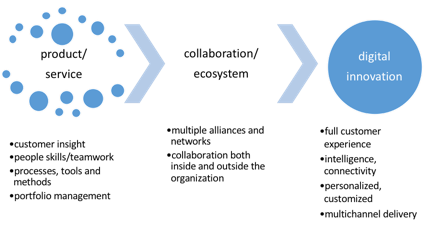There’s no turning back. Digital transformation has raised the stakes for innovation. New products and services must go beyond features and functions. The digital customer is king.
With the rise of smart connected technologies and the increasing blur between physical and digital delivery, today’s consumers expect complete experiences that more than meet their needs. They want products/services to understand them personally. They want 24/7 accessibility online, but they also want to see, touch, and feel products in person.
Digital consumers will share personal data if they trust it will benefit them (for example, MyFitnessPal). Their shared insights can help shape future offerings, but more importantly will help forge bonds. Trust is the operative word.
While technologies such as Artificial Intelligence (AI), Machine Learning, Analytics, etc. enable the development of such offerings, they’re only part of the equation. Data must be translated into insights, trust and human connection must be established, and delivery must be seamless. This must all be done with confidence and speed. Opportunity windows are short, competitors are everywhere.
Is your organization digitally capable?
For most of the firms we work with, new capabilities are needed. In fact, capabilities (or lack thereof) can make or break digital transformation. In our experience, innovation capabilities progress from product/service to digital innovation.
1. Product/service innovation
2. Collaborative innovation
3. Digital innovation
While the capabilities overlap, they also build on each other as follows:

- Product/service innovation is the ability to define, develop, and deliver profitable new offerings, ranging from incremental to breakthrough. Fundamental capabilities include:
- People skills such as creativity, drive, insight, pattern recognition, competitive and market awareness, etc.
- Teamwork – assigning the right people to the right jobs and blending diverse and complementary talents.
- Processes, tools, and methods to gather data and insights; test hypotheses and concepts; and more. Includes data analytics, algorithms, machine learning, AI, behavioral science, design thinking, and more to assist in data collection and interpretation.
- Customer insight derived from multiple sources, both online and in person. Know what questions to ask, listen empathetically without bias, identify the right ‘problems to solve’ and/or ‘jobs to be done.
- Portfolio management. Strategic capability in the areas of risk/reward assessment, idea/initiative management, project selection, go/kill decisions, and resource allocation.
- Collaborative innovation takes product/service delivery to the next level. Through partnerships, acquisitions, incubators and co-innovation centers companies can test new ideas and accelerate delivery as well as increase capability. Digital experiences require ecosystems and multiple alliances to coordinate the full spectrum of services and technologies. (Think Kroger with Microsoft retail-as-a-service platform, Instacart for same day delivery, Home Chef meal kit acquisition, Ocado for e-commerce, etc.) Internal collaboration must advance as well – R&D and marketing need to speak a common language and set unified goals. Software will increasingly be embedded with ‘hardware’ – agile development methods like scrums and time-boxed sprints should be part of the process.
- Digital Innovation Capabilities. Delivering fast, personalized customer experiences requires deep customer insight. Companies need to know what customers need now and what they will need in the future. This requires alignment between technology and business functions, along with shared real-time data. Capabilities and skills around data science, analytics and interpretation are paramount. The main technologies enabling digital transformation are data science, AI and machine learning, and the cloud.
Data science helps to understand and optimize the customer journey. AI and machine learning are necessary for personalization and enhancing the customer experience. With machine learning, large amounts of data can be translated into insight and action. Finally, cloud enables digital transformation and scalability on the infrastructure side.
Overall, organizational capability is achieved by continually building on existing competencies through leadership development, technical training/upskilling, knowledge sharing, mentorship programs, hiring and retaining top talent, partnering with and/or acquiring capable firms, updating tools and systems, funding/resourcing, and providing centralized access to data and insights.
The role of leadership cannot be overemphasized. At every level, function, and business unit there must be a culture of learning and experimentation, not fear. ‘Failures’ must not only be acceptable, they should be expected. Openness, teamwork, and honest communication should be nurtured and rewarded. The corporate vision and strategy must be articulated and well-understood.
Many companies are at the early stages of digital transformation, and there is still much to be learned. Nonetheless advancing these capabilities is high priority.
For more insight: We’ll be discussing this topic further in an upcoming podcast. If you have questions or experiences to share, or just want to talk personally, I’d love to hear from you! Send me an email (cperkins@innovationedge.com) or give me a call (920-205-3297) anytime.
